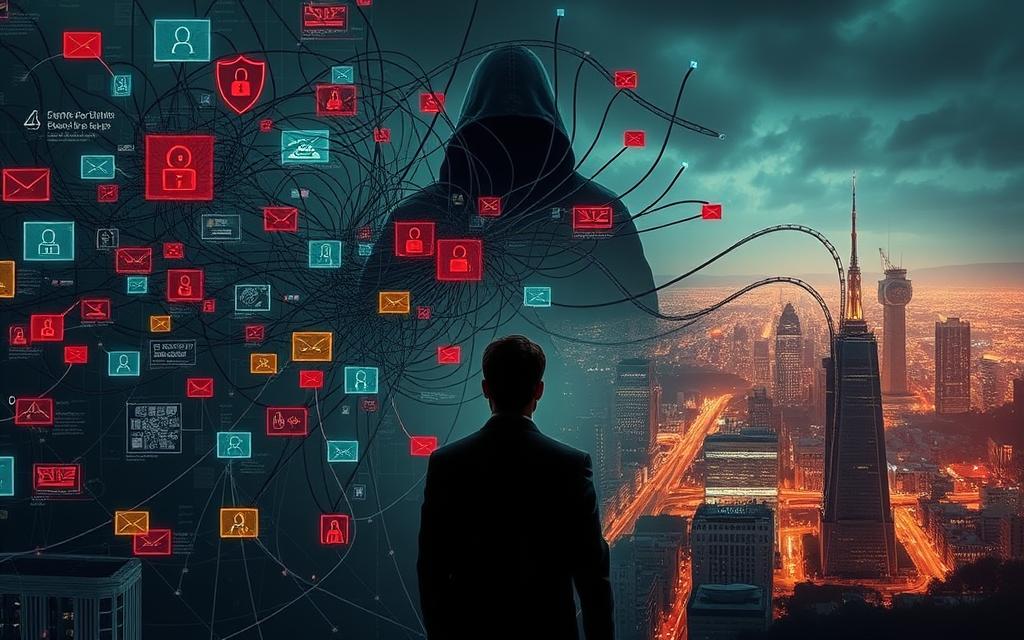Did you know a recent study found that around 60% of small U.S. businesses have faced a cyber attack? This startling fact points to the crucial need for strong cybersecurity. Our daily routines now heavily rely on technology, from managing our finances online to connecting on social platforms. So, the need to keep our internet use safe has never been more critical.
As cyber threats grow more advanced, understanding cybersecurity is key. This article will discuss the major online safety challenges Americans face today. We’ll look at various cyber threats and why it’s vital to learn and stay aware. Together, we’ll learn how to keep our personal and important information secure, promoting a culture of cybersecurity for all.
Understanding Cybersecurity: What It Is and Why It Matters
Cybersecurity includes many strategies to protect computers, networks, and data from harm. With technology growing, strong cybersecurity is more important than ever. Individuals and companies both need to keep their information safe.
The cost of not protecting this data is huge. In 2020, the world may have lost up to 6 trillion dollars because of cyberattacks. That’s why having good security to protect data is key.
The Importance of Cybersecurity
Today, keeping digital info safe is a big part of cybersecurity. If we’re not careful, hackers could get their hands on our private data. This could lead to more than just losing money. It could damage our reputation too.
By following good cybersecurity practices, we can keep our data safe. This helps make sure only the right people can access it.
Key Terms Everyone Should Know
Knowing some key cybersecurity terms can help you spot risks better. Here are some important ones:
| Term | Description |
|---|---|
| Malware | Malicious software designed to harm or exploit devices and networks. |
| Phishing | Fraudulent attempts to acquire sensitive information by masquerading as trustworthy entities. |
| Ransomware | Malware that encrypts a user’s data, demanding payment for access restoration. |
| Firewall | A network security system that monitors and controls incoming and outgoing network traffic based on predetermined security rules. |
Common Cyber Threats Facing Americans
In today’s digital world, Americans face several cyber threats. These threats can affect personal and organizational security big time. It’s important to know about them to stay safe.
Phishing Attacks
Phishing attacks are very common. Cybercriminals pretend to be someone you trust. They want you to give them your sensitive info, like passwords or bank details. Often, their emails or messages look very real. Clicking on a bad link can lead to stolen identities or hacked accounts.
Ransomware Exploits
Ransomware is a huge threat online. It’s nasty software that locks your files or system until you pay up. Remember the WannaCry attack in 2017? It showed how fast ransomware can shut down organizations. These attacks can cause big money losses and harm reputations. So, having strong security is key.
Malware and Virus Infections
Malware includes various harmful software like viruses, worms, and trojans. These can sneak into systems in many ways. They can lead to big problems, like stealing data or disrupting services. Virus infections can also damage files and mess up important functions. Knowing about malware and having good cyber habits are crucial for protection.
High-Risk Groups in Cybersecurity
Some people face more challenges with cybersecurity than others. Knowing how they use technology helps us keep them safe from harm. This way, we can protect those who are most at risk.
Seniors and Technology
Older adults often struggle with using the internet safely. They might not know how to spot dangers online. Because of this, scammers frequently target them. But, educating seniors can make a big difference in their safety online.
Small Businesses Vulnerabilities
Small businesses sometimes don’t have enough cybersecurity. They might not have strong protections in place. This makes it easier for hackers to attack them. The damage from these attacks can hurt both their money and their good name. It’s important for these businesses to get better at protecting themselves.
Essential Cybersecurity Best Practices
Today’s digital world makes cybersecurity crucial for all. By following important safety steps, both people and companies can lower cyber threat risks. This part points out top methods to improve IT security and keep data safe.
Strong Password Creation
Good passwords are key to cybersecurity. It’s smart to use different, complex passwords for every account, mixing letters, numbers, and symbols. Steer clear of simple passwords that are easy to crack. Changing passwords often adds extra security. A password manager can be very helpful in creating and keeping track of strong passwords.
Two-Factor Authentication (2FA)
Adding two-factor authentication (2FA) adds more security than just passwords. This step asks users to prove who they are with another check, like a text or an app, before they can get into their accounts. Using 2FA makes it much harder for hackers to get in and protects your info.
Regular Software Updates
Updating software regularly is key to keeping your defenses strong and your system secure. Hackers often attack old software with known flaws, so updates are critical. Turn on automatic updates when you can. This keeps all software and systems up-to-date, increasing IT security and defense against attacks.
The Role of Government in Cybersecurity
Government actions are key in boosting national security via impactful cybersecurity methods. They have rolled out plans to defend vital systems and confidential information. It’s insightful to see how these approaches help keep us and our economy safe from complex cyber dangers.
National Cybersecurity Strategies
Every country crafts a detailed cybersecurity plan for its unique risks. These plans typically include:
- Assessment of national cyber risks.
- Development of responsive policies and regulations.
- Investing in new cybersecurity tech.
- Educational campaigns for the public.
Collaboration with Private Sector
Since much of our nation’s infrastructure and data is in private hands, working together is crucial. Governments and businesses team up to:
- Share info on cyber threats.
- Create security solutions together.
- Offer training to improve skills.

| Government Initiative | Key Focus Area | Impact on National Security |
|---|---|---|
| The Cybersecurity Framework | Risk Management & Response | Makes us more resilient to attacks |
| National Cybersecurity Strategy | Policy Development | Makes our laws stronger |
| Cybersecurity Education Programs | Public Awareness & Training | Prepares our community better |
By working together, governments and businesses greatly enhance our national security. This creates a safer online world for everyone.
Impact of Social Media on Cybersecurity
Social media is key in shaping online security today. People often share too much online without thinking of the risks. This makes it easy for hackers to misuse data for bad deeds. Knowing how to stay safe online is super important.
Data Privacy Concerns
When we use social sites, we might put our privacy at risk. Things like posts, photos, and checking in places help hackers. They might steal identities or trick people. So, setting our accounts private is a must for staying safe online.
Misinformation and Scams
Fake news on social media can be dangerous. Scammers use lies to trick folks into giving away personal info or downloading viruses. Staying sharp and questioning what we read online is key to avoid being scammed.
| Data Privacy Risks | Associated Cybersecurity Threats |
|---|---|
| Oversharing personal information | Identity theft, account hacks |
| Clicking on unverified links | Phishing attacks, malware infections |
| Weak privacy settings | Data breaches, unwanted attention from cybercriminals |
| Spreading of false information | Manipulation, financial scams |
By knowing how social media affects us, we can be smarter online. This helps reduce risks and makes the internet safer for everyone.
Emerging Technologies and Cybersecurity Risks
Technology evolves constantly, bringing new cybersecurity challenges. Emerging tech like IoT and artificial intelligence expose networks to unique risks. It’s crucial for organizations to tackle these problems to protect data and system integrity.
Internet of Things (IoT) Security Issues
The Internet of Things connects everything from smart homes to industrial machines. Unfortunately, these devices often lack strong security, attracting cybercriminals. Poorly protected IoT devices can be hijacked, leading to data leaks and system tampering. It’s vital to strengthen IoT security to protect networks for individuals and businesses alike.
Artificial Intelligence (AI) Threats
Artificial intelligence, like IoT, brings cybersecurity concerns. While it can improve security efforts, AI can also aid in developing advanced cyber attacks. Hackers use AI to streamline their techniques, easily bypassing defenses to breach networks. Organizations need to use AI wisely in their security tactics and stay alert to AI-based threats.
Cybersecurity Insurance: Is It Necessary?
Cybersecurity insurance is now a must-have for businesses. With growing cyber threats, it’s critical to protect against data breaches, ransomware, and legal issues from data loss. Knowing what cybersecurity insurance includes helps businesses make wise choices about their coverage.
What Cyber Insurance Covers
Financial protection from this insurance covers several areas. It includes costs for data breaches, third-party liability, ransomware expenses, and more.
- Data breach costs, including notification and credit monitoring services
- Liability coverage for third-party claims resulting from a data loss
- Ransomware and cyber extortion expenses
- Business interruption expenses related to a cyber incident
- Legal fees associated with regulatory compliance and lawsuits
With more cyber incidents happening, businesses see the value in cybersecurity insurance. It’s a vital part of protecting data and reducing the impact of breaches.
Evaluating Your Business Needs
Evaluating your business’s risk before choosing a policy is key. You should consider the type of data you have, your industry’s rules, your size and tech, and your past security incidents.
- The nature of the data you handle, including sensitive customer information
- Your industry and its regulatory requirements
- Your company’s size and technological capabilities
- Previous incidents of data breaches or cyber attacks
This review helps figure out how much coverage you need. It also shows where you might need more risk management. Cybersecurity insurance should be part of a bigger plan to keep your business safe.
Education and Awareness in Cybersecurity
Understanding cyber education’s significance is essential today. It prepares us to face online dangers with knowledge and confidence. As online threats grow, knowing how to protect ourselves and our info becomes vital.
Importance of Cybersecurity Training
Cybersecurity training teaches us how to be safe online. It helps organizations and people protect themselves. Through training, people learn to spot scams, handle passwords, and set privacy correctly.
Resources for Learning Safe Practices
There are many ways to learn about cybersecurity. You can take online courses at your speed or attend workshops. These methods help build a safety-first mindset in the digital world.
The Future of Cybersecurity for Americans
Technology keeps moving forward, and so does the need to understand cybersecurity’s future. More people and companies rely on digital tools today. Knowing about cybersecurity trends is important to keep information safe. The threats online are changing, so we must change how we protect against them.
Trends to Watch
AI is getting bigger in fighting and planning security. It makes finding and stopping threats faster, helping to keep risks low. With more cloud services used, we need strong ways to keep data safe, especially when breaches happen. Staying safe online, while using new tech, is key to good security plans.
Preparing for Cyber Challenges Ahead
Getting ready for new cybersecurity problems means investing in advanced tech. Teaching employees about safety and keeping them updated is essential. This helps everyone spot dangers early. If we stay focused on safety and keep up with trends, we can fight off future cyber attacks. This will make our digital world safer.




